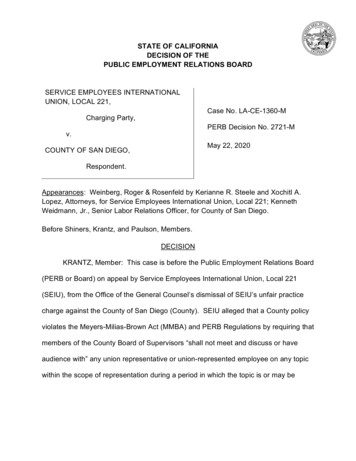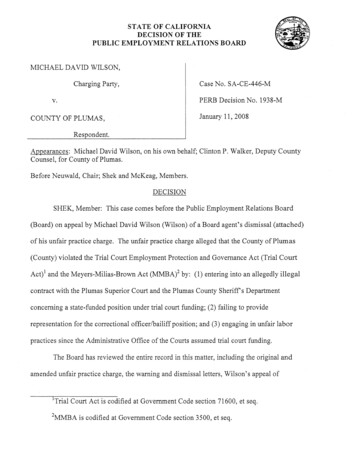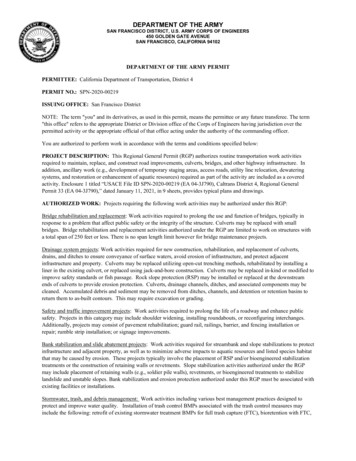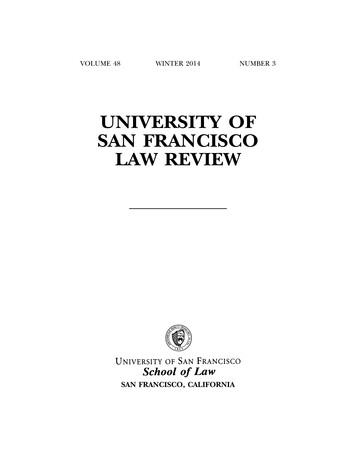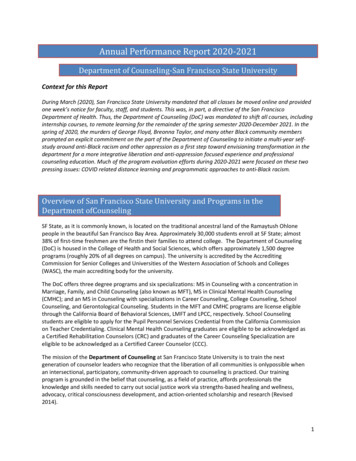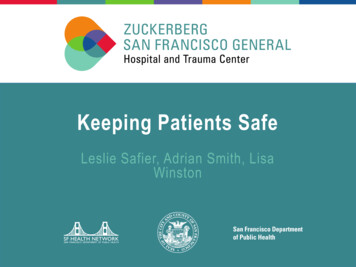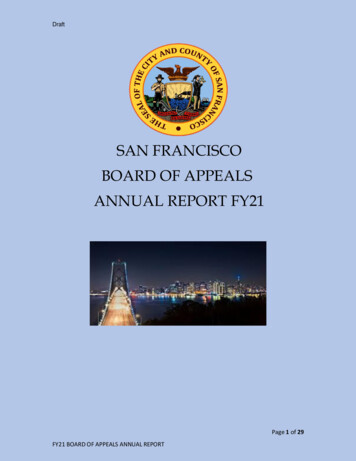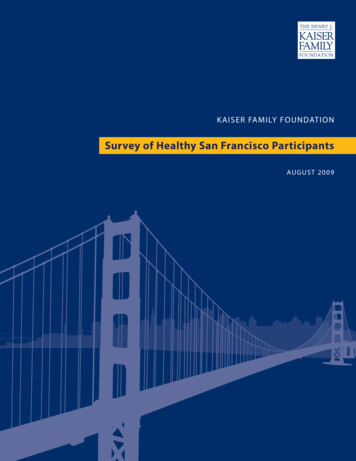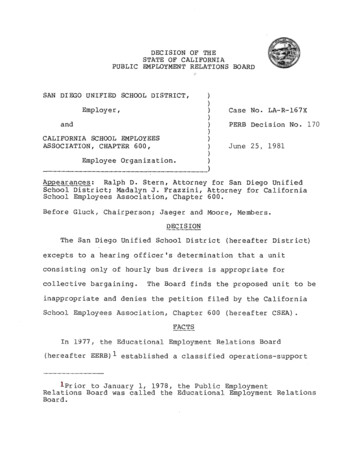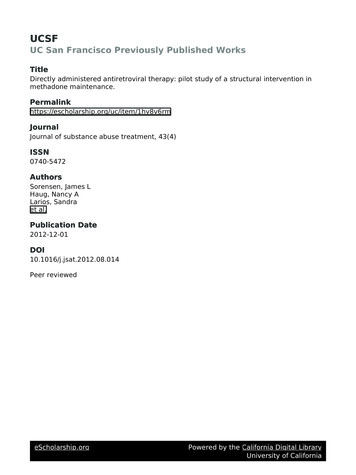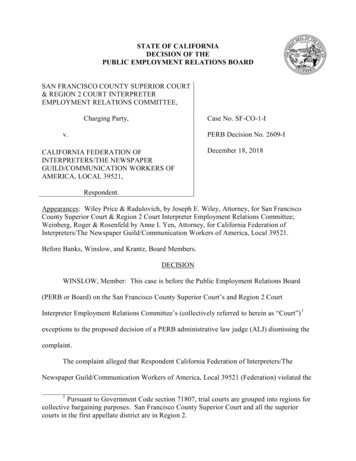
Transcription
STATE OF CALIFORNIADECISION OF THEPUBLIC EMPLOYMENT RELATIONS BOARDSAN FRANCISCO COUNTY SUPERIOR COURT& REGION 2 COURT INTERPRETEREMPLOYMENT RELATIONS COMMITTEE,Charging Party,Case No. SF-CO-1-Iv.PERB Decision No. 2609-ICALIFORNIA FEDERATION OFINTERPRETERS/THE NEWSPAPERGUILD/COMMUNICATION WORKERS OFAMERICA, LOCAL 39521,December 18, 2018Respondent.Appearances: Wiley Price & Radulovich, by Joseph E. Wiley, Attorney, for San FranciscoCounty Superior Court & Region 2 Court Interpreter Employment Relations Committee;Weinberg, Roger & Rosenfeld by Anne I. Yen, Attorney, for California Federation ofInterpreters/The Newspaper Guild/Communication Workers of America, Local 39521.Before Banks, Winslow, and Krantz, Board Members.DECISIONWINSLOW, Member: This case is before the Public Employment Relations Board(PERB or Board) on the San Francisco County Superior Court’s and Region 2 CourtInterpreter Employment Relations Committee’s (collectively referred to herein as “Court”) 1exceptions to the proposed decision of a PERB administrative law judge (ALJ) dismissing thecomplaint.The complaint alleged that Respondent California Federation of Interpreters/TheNewspaper Guild/Communication Workers of America, Local 39521 (Federation) violated the1Pursuant to Government Code section 71807, trial courts are grouped into regions forcollective bargaining purposes. San Francisco County Superior Court and all the superiorcourts in the first appellate district are in Region 2.
Trial Court Interpreter Employment and Labor Relations Act (Court Interpreter Act) 2 bydeviating from the parties’ collective bargaining agreement (CBA) section governing sympathystrikes without affording the Court notice and an opportunity to meet and confer. Thecomplaint also alleged that the Federation failed to meet and confer in good faith when it (1)engaged in a surprise strike; (2) called for, authorized, assisted, encouraged, sanctioned,ratified, condoned, or lent support to essential employees to withdraw their services; and (3)engaged in a sympathy strike during an unlawful primary strike by Service EmployeesInternational Union Local 1021 (SEIU).The ALJ found that these allegations lacked merit, concluding mainly that theFederation did not engage in a sympathy strike. The ALJ found that the Federation notified 10of its bargaining unit members that the CBA prohibits sympathy strikes but allows employeesto ask for an alternative assignment if crossing a picket line is against their conscience.Because the ALJ found that the Federation appropriately informed employees about aprovision in the Federation’s CBA with the Court, and did not call for a sympathy strike, theALJ determined that she did not need to resolve whether the alleged sympathy strike wasunlawful. Under the ALJ’s reasoning, even assuming for the sake of argument that it couldhave been unlawful for the Federation to call a sympathy strike under one or more of the legaltheories set forth in the complaint, the Federation did not call for interpreters to do anythingother than to consider whether to request reassignment as expressly permitted in a contractprovision that the Court itself negotiated.The Court excepts to how the ALJ framed the issue and to some of her conclusionsabout the interpretation of the parties’ CBA, whether a sympathy strike occurred, and whether2The Court Interpreter Act is codified at Government Code section 71800 et seq.Unless otherwise specified, all statutory references herein are to the Government Code.2
there was an unlawful sympathy strike. The Federation filed no exceptions and asks us toaffirm the proposed decision.The Board has reviewed the Court’s exceptions and the Federation’s responses thereto,the proposed decision, and the entire record in light of applicable law. Based on this review,the Board has determined that the ALJ’s findings of facts are adequately supported by therecord as a whole. The Board has also determined that the ALJ’s legal conclusions are wellreasoned and in accordance with applicable law. Accordingly, we affirm the dismissal of thecomplaint and underlying unfair practice charge in accordance with our discussion of theCourt’s exceptions.FACTUAL BACKGROUNDSan Francisco County Superior Court is a trial court within the meaning of CourtInterpreter Act section 71801 subdivision (k) and PERB Regulation 32035 subdivision (b). 3The Region 2 Court Interpreter Employment Relations Committee is a regional courtinterpreter employment relations committee within the meaning of Court Interpreter Actsection 71801 subdivision (h), a regional committee within the meaning of PERB Regulation32035 subdivision (a), and an employer within the meaning of PERB Regulation 32035subdivision (e). The Federation is an employee organization within the meaning of CourtInterpreter Act section 71801 subdivision (c), a recognized employee organization within themeaning of Court Interpreter Act section 71801 subdivision (g), and an exclusiverepresentative within the meaning of PERB Regulation 32035 subdivision (c).During the period relevant to this dispute, the parties had a collective bargainingagreement in effect. Article 42 (No Strike/No Lockout) reads:3PERB Regulations are codified at California Code of Regulations, title 8, section31001 et seq.3
A.No Strikes or LockoutsDuring the term of this Agreement, the Union, its officers, agents,representatives, stewards and members and all other employeesshall not, in any way, directly or indirectly, engage in any strike,sympathy strike, slowdown, work stoppage, picketing, or anyother interference with or interruption of court work in any Courtoperations. . . .B.Crossing Sanctioned Picket LinesIf an employee covered by this Agreement is expected to cross apicket line set up due to a labor dispute sanctioned by a CentralLabor Council in the Region, and if crossing that picket line is inconflict with the employee’s conscience, the Chief ExecutiveOfficer or his/her designee will meet with the Union, if requested,within 24 hours to attempt to reassign the employee in a mannerwhich retains Court services and does not result in disciplinaryaction against the employee.Neither party produced evidence about the bargaining history or prior interpretations ofArticle 42.Anabelle Garay (Garay) is the Federation representative that works with the SanFrancisco Superior Court employees. On Friday, October 10, 2014, she was preparing to go tothe Federation’s annual conference in Los Angeles. She first heard SEIU may be considering astrike at the San Francisco Superior Court at some point on Friday, October 10, 2014, whenFederation member Daniel Navarro (Navarro) forwarded her an e-mail from SEIUrepresentative Steve Stallone (Stallone). Navarro’s e-mail stated SEIU would strike onTuesday, October 14, 2014.After receiving the e-mail, Garay contacted her supervisor at the Federation, SaraSteffens, and also contacted the Federation’s attorneys seeking clarification about “what wecould and couldn’t do and what we needed to advise our members should they have questions.”She left for the conference in the morning. At 12:01 p.m., she sent an e-mail to Stallone to ask4
if the strike was sanctioned by the California Labor Federation or the San Francisco LaborCouncil. He responded at 4:25 p.m. that SEIU Local 1021 “definitely has strike sanction fromthe SFLC.” He also urged that “you have a no strike clause in your contract and that meansyou can’t strike, but you still have the right to respect a picket line and not cross it. That is nota strike. Unions do it all the time. . .” Due to her participation in the conference, Garay didnot take further action until Monday, October 13, 2014.On Monday, October 13, 2014, Garay sent an e-mail to 10 San Francisco courtinterpreters. Her e-mail read:Dear SF Interpreters and cross assigners:Our SEIU 1021 coworkers in San Francisco courts are preparingto strike tomorrow (Tuesday). As you know, our contract tiesbenefits for interpreters to that of the largest bargaining unit. InSF that’s the clerks repped by SEIU, a group of employees whohas supported CFI in work actions before. While we areprevented from going on a sympathy strike and picketing as aunion, all of you can take individual steps if crossing the picketline is against your conscience.If you are scheduled to work and do not feel comfortable crossingthe picket line because it’s against your conscience, please notifythe coordinator of this and ask for an alternative placement. Alsocontact me also. I will be in SF court and reachable by cell.[number omitted].Anabelle GarayField RepresentativeCalifornia Federation of Interpreters(Emphasis added.)Garay did not receive any responses to her e-mail. Other than with Navarro, Garay didnot have any other communications about the strike with Federation members betweenOctober 10, 2014 and the strike.5
The Federation did not call for a sympathy strike. In order to call a strike, theFederation would need a recommendation from its bargaining committee, a membership vote,input from its executive board, and approval from the Labor Council. None of those stepsoccurred. Neither Garay nor any other authorized representatives of the Federation asked anyinterpreters to not work in support of the SEIU strike.On October 14, 2014, Garay received an e-mail from Stallone that said SEIU had set uppicket lines starting at about 6:30 a.m. She went to the Civic Center Courthouse the morningof the strike and saw picket lines and, around lunchtime, went to the picket line at the Hall ofJustice. At some point she spoke at a microphone to express solidarity with SEIU.At the time of the strike, J.M. Munoz (Munoz) was the principal human resourcesanalyst for the Court. He was also chief labor negotiator for the Court and the principal forcommunications related to labor disputes and union issues. He learned of SEIU’s strike votewithin a week or two prior to the strike. He found out about the strike itself at about 7:30 a.m.on October 14, 2014 when his supervisor texted him about it.During the strike, Munoz triaged critical needs and operations, at which point helearned that most of the Spanish interpreters refused to cross the picket line. They were callingin and reporting it was against their conscience to cross the picket line. The Court notes in itsbrief that nearly all of these interpreters followed a script when they called. That scriptappears to be modeled on an October 12, 2014 e-mail from Navarro which encouragesinterpreters who did not want to cross to call their supervisor and state in part, “I amrequesting reassignment.” (Bold in original.) Munoz did not contact Garay or any otherFederation representative that day to discuss the interpreters’ requests. The Court did notproduce evidence it investigated potential reassignments, and there is no evidence that the6
Federation urged interpreters to resist or refuse any lawful response by the Court to theirreassignment requests or gave instruction on what they should do if the Court said it hadsearched and could not find an appropriate reassignment. The Court did not discipline theinterpreters who did not cross the picket line.DISCUSSIONTo establish a prima facie case of unilateral change, the charging party must presentfacts establishing the respondent breached or altered the parties’ agreement and that the breachor alteration amounts to a change of policy, evidenced by a generalized effect or continuingimpact on negotiable terms and conditions of employment of bargaining unit members. (GrantJoint Union High School District (1982) PERB Decision No. 196 (Grant); City of Davis(2016) PERB Decision No. 2494-M, p. 24.) The standard is equally applicable to unilateralrepudiations by an employer or by an employee organization. (Oxnard Harbor District (2004)PERB Decision No. 1580-M.) Thus, to prevail, the Court must demonstrate that Article 42prohibits the conduct Federation members engaged in, and the Court must further prove thatthe Federation is responsible for such violations.An established policy may be embodied in the terms of the parties’ CBA. (Grant,supra, PERB Decision No. 196, p. 8; Pasadena Area Community College District (2015)PERB Decision No. 2444, p. 12.) Although PERB lacks authority to enforce contracts, it mayinterpret contracts when necessary to resolve an alleged unfair practice. (County of Sonoma(2011) PERB Decision No. 2173-M, p. 16.)When required, PERB interprets collective bargaining agreements according to theirplain meaning if the language is clear. (Trustees of the California State University (1996)PERB Decision No. 1174-H; Marysville Joint Unified School District (1983) PERB Decision7
No. 314.) If the language is ambiguous, the Board may consider extrinsic evidence, such asbargaining history, where available. (Los Angeles Unified School District (1984) PERBDecision No. 407.) The Board also attempts to harmonize contract provisions to give meaningto each provision. (Victor Valley Community College District (1986) PERB DecisionNo. 570.)In Los Angeles Superior Court (2010) PERB Decision No. 2112-I, the Board explainedits guiding principles for harmonizing contract provisions:When interpreting collective bargaining agreements, including inunilateral change cases, the Board applies traditional rules ofcontract law, such as the provisions of Civil Code sections 1638and 1641. (King City Joint Union High School District (2005)PERB Decision No. 1777; see also, City of Riverside (2009)PERB Decision No. 2027-M.) Each contract clause must be readin conjunction with phrases surrounding it and harmonized as awhole. (Long Beach Community College District (2003) PERBDecision No. 1568.) The Board’s interpretation shouldharmonize any potential conflict between provisions of theagreement and give a “reasonable, lawful and effective meaningto all the terms,” as provided in Civil Code section 1641. (KingCity Joint Union High School District, supra, PERB DecisionNo. 1777.) The interpretation given must avoid leaving anyprovision without meaning. (City of Riverside, supra, PERBDecision No. 2027-M.)Here, Article 42.A. forbids “the Union, its officers, agents, representatives, stewardsand members and all other employees” from “in any way, directly or indirectly, engag[ing] inany . . . sympathy strike.” But Article 42.B. provides a procedure that applies when crossing apicket line would conflict with an employee’s conscience.The Court urges that Federation members not crossing SEIU’s picket line constitutes asympathy strike prohibited by Article 42.A. In support of this assertion, the Court points to thefact that the Federation’s e-mail to its members mentioned a linkage between benefits SEIUobtains and those to which Federation bargaining unit members would be entitled. The Court8
also cites to Garay’s speech in support of SEIU’s strike at a noontime rally on the day of thestrike. Yet neither these facts nor others cited by the Court demonstrate that the Federationrepudiated Article 42 when it notified 10 bargaining unit members regarding Article 42’sprovisions.Here, Article 42 plainly describes two different types of conduct: sympathy strikes,which are prohibited, and not crossing a picket line, which is subject to the aforementionedaccommodating language. 4 Thus, when both subparts are harmonized, Article 42 prohibitssympathy strikes, but does not in any way prohibit the Federation from informing membersregarding relevant contract provisions. In this case, the Federation merely advised its membersof the applicable contractual provisions, and in doing so, did not repudiate the CBA orotherwise violate the Court Interpreter Act.The Court admits that Article 42.B. “allows an individual employee to be reassigned ifcrossing a picket line is in conflict with the employee’s conscience.” Despite this admission,the Court urges us to read into employees’ rights under Article 42.B. a limitation not reflectedin the contractual language. Specifically, the Court claims that if the employee’s objection tocrossing a picket line is based on the employee’s support of another union, then that is not amatter of conscience and Article 42.B. offers no protection. The Court does not offer anyextrinsic evidence to support this interpretation and we reject this false dichotomy. (Regents ofthe University of California (2004) PERB Decision No. 1638-H, p. 4 [where language in nostrike clause is susceptible to more than one interpretation, burden is on charging party4Indeed, it appears Federation member Navarro anticipated the Court reassigninginterpreters who refused to cross the picket line when he e-mailed Federation members that“Administration . . . are [sic] looking at other ways of getting us access into the building” ifmembers decline to cross SEIU picket lines.9
employer to provide extrinsic evidence manifesting “clear mutual intent” as to the employer’spreferred interpretation]; accord Oxnard Harbor District, supra, PERB Decision No. 1580-M,p. 9.)In reaching this conclusion, we note that the parties agree that subsection B ofArticle 42 permits an employee to be reassigned if crossing a picket line is in conflict with theemployee’s conscience, and disagree mainly as to the meaning of the term “conscience.” Inthe absence of any evidence of what the parties intended when they bargained the terms ofArticle 42.B., there is no basis for the Court’s peculiar proclamation that “conscience”somehow precludes employees acting on what they may consider an ethical imperative to showsolidarity with striking employees. Given that supporting another union is protected underother PERB-administered statutes 5 (McPherson v. PERB (1987) 189 Cal.App.3d 293, 309311), any waiver of that right would need to be clear and unmistakable. (San Marcos UnifiedSchool District (2003) PERB Decision No. 1508, pp. 27-30.) Here, the plain language of thecontract expressly confirms an employee’s basic right to support another union. If the Courtintended a term like “conscience” to function as some form of limitation on this right, it wasplainly incumbent upon the Court to negotiate such a limitation more clearly and unmistakably.It did not do so.In Re Teamsters Local Union No. 688, on which the Court relies, does not aid itsargument. (In Re Teamsters Local Union No. 688 (2005) 345 NLRB 1150 (Teamsters).) InTeamsters, the National Labor Relations Board (NLRB) found that the CBA barred sympathystrikes, even though another provision permitted employees to refrain from crossing picket5It is appropriate for PERB to apply precedents developed under other actsadministered by the Board. (Service Employees International Union, Local 790 (Banks, et al.)(2004) PERB Decision No. 1636-M.)10
lines. (Id. at p. 1151.) In harmonizing these provisions, the NLRB concluded that individualshonoring picket lines is distinct from a sympathy strike, and the prohibition on sympathystrikes was entirely consistent with the contract language allowing “an individual employee tomake a personal decision as to whether to honor a third-party picket line.” (Ibid.) Teamstersis distinguishable from the instant case in the specifics of the contract language at issue.Moreover, that case involved union conduct that was very different from the facts here, wherethe ALJ was correct in characterizing the Federation’s conduct as informing employees aboutthe applicable provisions in their CBA. The primary import of Teamsters, then, is that it showshow bargaining unit members making individual decisions when faced with a different union’spicket line is distinct from their union calling a sympathy strike. In Teamsters, that distinctionmeant a union could not punish members for their individual decisions not to honor a picketline. Here, it supports our conclusion that action by individual Federation bargaining unitmembers did not amount to an impermissible sympathy strike by their union.The Federation’s internal communications, as well as its communication to members,demonstrates that the Federation informed 10 bargaining unit members regarding the relevantcontract language. Directing the interpreters’ attention to contract language cannot amount toa repudiation of that language.The nature of the Federation’s actions here also defeats the Court’s alternative theoriesthat the Federation violated the Court Interpreter Act by allegedly calling for a strike withoutadequate notice, or calling for a sympathy strike in which, the Court claims, the Federation“stands in the shoes” of SEIU. We need not delve into the extent to which such allegedconduct by the Federation would or would not amount to an unlawful pressure tactic, because11
we affirm the ALJ’s well-supported factual conclusion that the Federation did not engage insuch conduct and instead informed its members of the relevant contract language.The Court has similarly failed to meet its burden of showing that the Federation called asympathy strike that would imminently and substantially threaten the public health or safetywithin the meaning of County Sanitation District No. 2 of Los Angeles County v. Los AngelesCounty Employees Association, Local 660 (1985) 38 Cal .3d 564 (County Sanitation). UnderCounty Sanitation, for a strike to be found unlawful, it must be “‘clearly demonstrated,’ on acase-by-case basis, that [specific employees’] participation in a strike would create animminent and substantial threat to public health and safety.” (Sacramento County SuperiorCourt (2015) PERB Order No. IR-59-C, p. 2 citing County Sanitation, supra, at pp. 586-587,emphasis omitted.) In determining whether an employer has met its burden, we consider,among other factors, the nature of the work and the extent to which supervisors, temporaryemployees, replacement workers, and others can perform the work on a temporary basis, aswell as the duration of the strike. (Sacramento County Superior Court, supra, PERB OrderNo. IR-59-C., pp. 2-3.)Even if we were to find that the Federation had called a strike, the Court fell far short ofits burden under County Sanitation. At hearing, the Court called just two court employees.Munoz, a principal human resources analyst and the Court’s chief negotiator at the time of thestrike, testified his “area is only Human Resources” and he did not know how manycourtrooms were scheduled to be in session or many specifics about the impact of interpretersnot crossing the picket line. He testified that about 90 percent of the clerks represented bySEIU went on strike and did not know how many, let alone which, courtrooms were able to runwithout the clerks. He did not identify any courtrooms requiring an interpreter that were able12
to run that day in the absence of the clerks. Not knowing many specifics, he could onlyspeculate that some interpreters not coming to work could “potentially” affect some courtfunctions.Mark Culkins, a court administrator at the time of the strike, testified “we wouldn'tassign an interpreter to a department if there was no Court in session that day” and did notidentify any courtrooms that were in session with the clerks out on strike that needed aninterpreter. He also acknowledged the Court had a pool of replacement workers available tostaff court interpreter duties, even on same-day notice. He testified that only twelve to fifteenof the court’s interpreters are employees. In addition to employees, “We have cross assignedinterpreters from other jurisdictions and we also hire contracted interpreters from time to time,depending on the needs of the Court.” He explained cross-assigned interpreters work inAlameda County or other counties in their Region and “if we need an assignment, we'll go tothose Courts and ask for them to provide different types of interpreters depending on ourneed.” In addition, the court has “access to contracted folks that they can call through eithercompanies or agencies.” The Court routinely uses cross-assigned interpreters or contractors,such as when an employee is sick, and cross-assigners and contractors are available for sameday absences. But the Court did not attempt to call in replacement workers for this one-daystrike. In these circumstances, we need not reach the issue, raised by the Court’s presentationat trial, of whether the Court had insufficient time to contact all of the agencies potentiallycapable of providing replacement interpreters and to document the extent to which each agencycould provide such replacements. (Sacramento County Superior Court, supra, PERB OrderNo. IR-59-C, p. 3.)13
ORDERThe unfair practice charge and complaint in Case No. SF-CO-1-I are herebyDISMISSED.Members Banks and Krantz joined in this Decision.14
San Francisco County Superior Court is a trial court within the meaning of Court Interpreter Act section 71801 subdivision (k) and PERB Regulation 32035 subdivision (b).3 . The Region 2 Court Interpreter Employment Relations Committee is a regional court interpreter employment relations committee within the meaning of Court Interpreter Act
